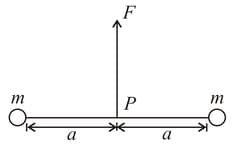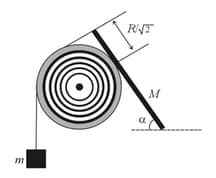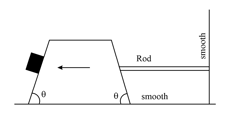Newton's Second Law of Motion
Newton's Second Law of Motion: Overview
This Topic covers sub-topics such as Mass, Newton's Second Law of Motion, Units of Force, Units of Mass, Linear Momentum, Resultant Force, Rate of Change of Momentum, Change of Momentum, Properties of Force and, Limitations of F= ma
Important Questions on Newton's Second Law of Motion
A lift weighing is moving upwards with an acceleration of . The tension in the supporting cable is
Two particles of mass each are tied at the ends of a light string of length The whole system is kept on a frictionless horizontal surface with the string held tight so that each mass is at a distance from the centre (as shown in the figure). Now, the mid-point of the string is pulled vertically upwards with a small but constant force As a result, the particles move towards each other on the surface. The magnitude of acceleration, when the separation between them becomes is

A block of mass is placed on a horizontal frictionless plane. A second block of mass is placed on it and is connected to a spring of spring constant the two blocks are pulled by distance . Block oscillates without slipping. What is the maximum value of frictional force between the two blocks?

Three identical blocks of masses are drawn by a force on a frictionless surface, then what is the tension (in ) in the string between the blocks and ?

A player caught a cricket ball of mass moving at a rate of . If, the catching process is completed in , the force of the blow exerted by the ball on the hand of the player is equal to
A particle of mass is subjected to a force with . What will be its initial acceleration if it is released from a point away from the origin?
A machine gun fires a bullet of mass 40 g with a velocity 1200 . The man holding it can exert a maximum force of 144 N on the gun. How many bullets can he fire per second at the most?
A rocket with a lift-off mass is blasted upwards with an initial acceleration of . Then the initial thrust of the blast is nearly –
The weight of a body depends on its mass but, the mass of the body does not depend on its weight.
Explain weight and how it is different from mass?
What is the concept of mass? What is difference between inertial and gravitational mass ?
Evaluate the Direction & Magnitude of the Net Force of a Stone of Mass 6 Kg Falling Out of the Window of a Stationary Bus.
The application of force on an object may change its _____.
What is a simple definition of force?
Is force a vector quantity True or false?
Through a smooth fixed cylinder of radius , the axis of which is horizontal, a weightless rope is thrown, to the ends of which a load and a thin uniform rod is attached as shown in the figure. In the position of equilibrium, rod makes an angle with the horizontal. The distance from the end of rod to which the rope is attached, to the point of contact of the rod and the cylinder is . If mass of rod is , then find the value of mass in .

In the diagram shown, no relative motion takes place between the wedge and the block placed on it. The rod slides downwards over the wedge and pushes the wedge to move in horizontal direction. The mass of wedge is equal to and is same as that of the block. If find the mass of rod (in kg) (Neglect rotation of the rod)

